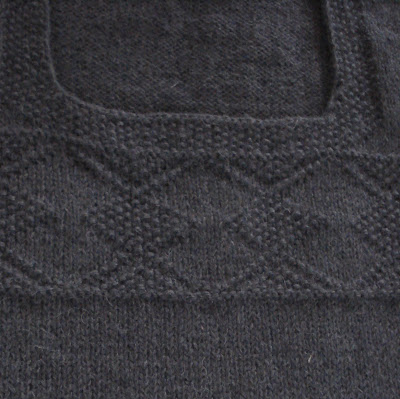The pattern is from 1970 bought as a kit at Frilandsmuseet, an open air museum, by a Danish woman, who knit the pullover it as part of her Danish national costume. She emigrated in the 1950ies to Canada, bringing her 7-year-old daughter with her. This daughter is now a Canadian, and also a raveller and thanks to Ravelry, we have come across.
Knowing my interest in historic knitting, she offered me the Nattrøje pattern and I was really thrilled. The yarn brand ÅLJ is still available in a knitting store in my town, so I just followed the pattern exactly as written. It was an easy knit. I just had to hit the gauge, for me it was on needle size 2½ mm,
The original color was red, however this color is discontinued and I chose an anthracite gray.
The construction is based on a Nattrøje from 1775 from the Danish National Museum.
For more than 150 years this woolen pullover was a part of the clothes worn daily by Danish rural women.Over a linen shirt, under a waistcoat. Knit in wool by professionals they were an imitation of the nobles´silk shirts.
Fashion changed and gradually from 1850 it became a full dress, a national costume, worn Sundays and for celebrations.
Nowadays the costume is worn by people who is interested in maintaining old Danish folk dance.
The knit designer Åse Lund Jensen was trained as a dressmaker in Haute Couture ,which is obvious looking at this tailored piece.
Åse Lund Jensen died in 1977 only 57 years old. She had met Marianne Isager, a talented young knit designer in 1973 and left her all her works and Marianne continued her work of making knitting an art form.
Many of Marianne Isager´s designs are based on Åse Lund Jensens work. This model, 77, is built on the same 1775 model and can easily be added some of the Nattrøje patterns.(Only in Danish)


My pattern is personal. However, there are several options if you want to knit an old Danish Nattrøje.
Uuve Snidare: Fiskertrøjer og andre klassiske trøjer. Her book is available in Swedish, Danish, and German. Search the library.
Vibeke Lind :Strik med nordisk tradition Danish and English, also library stuff.
Why these two books are not republished is a mystery to me.
And of course Beth Reinsel- Brown´s Nattrøje sweater from Interweave PressIf you have 1½ minutes to spare, look at this dance. For me it looks like knitting and weaving. Can you also see the purls?



















